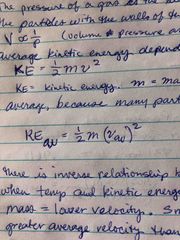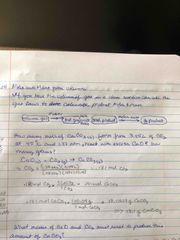![]()
![]()
![]()
Use LEFT and RIGHT arrow keys to navigate between flashcards;
Use UP and DOWN arrow keys to flip the card;
H to show hint;
A reads text to speech;
35 Cards in this Set
- Front
- Back
- 3rd side (hint)
|
The amount of force per area is called: |
Pressure |
|
|
|
What is an atm? |
Atmospheric pressure unit of measure in inches. 1 atm = 29.9 inches |
|
|
|
What is torr? |
Atmospheric pressure measure. 760 torr = 1 atm = 101325 pascals |
|
|
|
The pressure of a gas is 8.25 * 10^4 pa. What is atm of this gas? |
8.25*10^4 pa * 1 atm/101325 pa |
= .81 atm |
|
|
The pressure of a gas is 8.25*10^4 pa. What is torr for this gas? |
8.25*10^4pa * 1 atm/ 101325pa * 760torr/ 1 atm |
618.8 torr |
|
|
Boyle’s law |
For a given mass of gas at a constant temperature volume varies inversely with pressure |
V = constant/P |
|
|
V = constant/P |
Boyle’s law. volume is inverse of pressure |
|
|
|
What is the Ideal gas law equation. Gas behaves according to predicted linear relationship. |
P1 V1 = P2 V2 |
|
|
|
P1V1 = P2V2 solve for V2 |
V2 = P1V1/ P2 |
|
|
|
P1V1 = P2V2 solve for P2 |
P2 = P1V1 / V2 |
|
|
|
Gases in a mixture behave independently and exert the same pressure they would exert if they were in a container alone. |
Dalton’s law of partial pressure |
|
|
|
How to calculate molar mass from density |
n=PV/RT —> mass (g) / moles |
|
|
|
Density formula |
D=M/V |
|
|
|
Convert torr to atm |
X torr = atm/760 torr |
|
|
|
P = Pa + Pb + Pc ... |
Sum of partial pressures Dalton’s law of partial pressures |
|
|
|
Kinetic molecular theory 1 |
Gases are composed of small and widely separated particles |
Spacing |
|
|
Kinetic molecular theory 2 |
Particles of gas behave independently of one another |
Independent behavior |
|
|
Kinetic molecular theory 3 |
Each particle is in rapid straight line motion until it collides with another particle or container. |
Collision, trajectory, speed |
|
|
Kinetic molecular theory 4 |
The pressure of a gas is the sum of the collisions of the particles with the walls of the container. |
What happens when gas collides with walls of container? |
|
|
Kinetic molecular theory 5 |
Average kinetic energy is dependent on absolute temperature. |
|
|

Front (Term) |
Average kinetic energy equation KE = kinetic energy m = mass of gas particle |
|
|
|
The Movement of gas particles from regions of high concentration to low concentration is called: |
Diffusion of gas |
|
|
|
Which gas particle moves slower? Heavy or light |
Heavy |
|
|
|
The passage (escape) of gas through a small opening into a vacuum is called: |
Effusion |
|
|
|
If pressure is constant volume and temperature are directly proportional to each other V1/T1 = V2/T2 |
Charles’s law |
|
|
|
When at a given temperature and pressure, equal volumes of all gases contain equal numbers of moles, is known as: |
Molar volume |
|
|
|
Volume _______ as moles of gas ___________? |
Increase Increase V1 Moles1 = V2 Moles2 |
|
|
|
V1/N1 = V2/N2 |
Avogadro hypothesis. Volume and moles of gas correspond |
|
|
|
Moles and mass from volume |
If you have the volume of gas in a chemical reaction use the gas laws to calculate the amount of product moles and mass |

|
|
|
Moles and mass from volume path |
Volume gas -> PV=nRT -> Moles of gas -> Mole ratio from chem equation -> Product moles -> Molar mass equation -> Product grams |
|
|
|
The formula for pressure is |
P = F/A |
|
|
|
Convert atm to torr |
1 atm = 760 torr |
|
|
|
Convert atm to inches (hg) |
1 atm = 29.9 inches |
|
|
|
What is pa (pascals) |
An atmospheric unit of pressure. 1 atm = 101325 pa |
|
|
|
1 atm = 29.9 inches = 760 torr = 101325 pascals |
1 atm = 29.9 inches = 760 torr = 101325 pascals |
|

